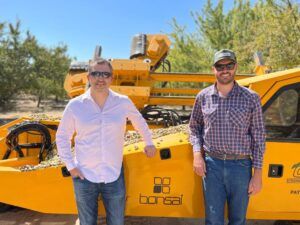“Agtech point solutions focused on improving the efficiency of current farming practices are great but they are not going to provide venture capital firms with the exit returns they need to justify their business model.”
Nolan Paul, Partner at Yamaha Motor Ventures and ex-head of R&D Strategy and Emerging Technology at leading produce grower Driscoll’s is offering his thoughts on how the agritech sector is developing ahead of his speaking slot at World Agri-Tech Innovation Summit in San Francisco next week.
A large portion of Farm Tech startups is building technologies to help growers increase their yields and farm more efficiently — from reducing their use of fertilizers and water, to pinpointing issues in the field. Many of these startups are offering a single solution, such as a soil moisture sensor or aerial imagery, but they’re unlikely to have more than an incremental impact on the agriculture industry, and that means the potential for VC returns is limited, argues Paul.
In 2018, nearly $1 billion was invested in Farm Management Software, Sensing & IoT — the category that encompasses many of these “point solutions” Paul is referring to.
“This is one of my main worries for this sector. I understand investments in farm tech tools that can help farmers increase yields incrementally as a strategic investment by a corporate or the industry, but I see a lot of [commercial] VC money going into tools where I don’t really see a massive exit, and if they’re not going to get a massive exit, I don’t understand how they’ll achieve the general returns they need to justify agtech as a sector.”
Paul pointed to one of agtech’s most successful exits in Blue River Technologies, the robotic “see and spray” tractor attachment technology that John Deere acquired for $305 million in 2017. “To be clear, that is a transformational technology. But even then, imagine you were an early investor and say you owned 10% at exit, that’s $30 million; on a $200 million or so fund, they won’t have even returned one-sixth of the fund – and that’s a big all-star exit for Ag.”
Paul is by no means skeptical about the potential for robotics specifically in agriculture; labor is a major challenge across the industry and a key focus area for Yamaha’s investment portfolio. It is invested in Robotics Plus, Soft Robotics, and Abundant Robotics – all focused on the food & ag supply chain — through its strategic investment arm in the food and space.
But the company’s new exploratory fund, which Paul likens more to commercial VCs in terms of expectations and LP/GP structure, Yamaha is looking for disruptive businesses, not incremental technologies, that won’t necessarily be acquired by the incumbent food and ag companies but be built as standalone businesses.
And these are not one product companies, he said exampling Indigo Agriculture and Farmers Business Network (FBN) as the types of disruptive businesses the exploratory fund looks for; both have built a suite of products for farmers and others in the supply chain in an effort to upturn the way the whole value chain does business. Both are also using a range of different technologies from digital and ecommerce to biotech (seeds and microbes). Indigo was valued at around $3.5 billion at its last investment round and FBN is circling the $1 billion mark.
For true disruptive potential, Paul also believes technologies need to be solving for major societal challenges in the next 10 years; a key tenet of Yamaha’s investment thesis and value as a company.
At the company level, Yamaha recently shifted its focus to not just deliver joy and excitement to consumers through its products – think high-speed motorcycles etc — but to helping deliver the United Nations’ Sustainable Development Goals (SDGs).
“If you extrapolate that out in agriculture, there are lots of really interesting things to look at. Agriculture has a massive social and environmental footprint across the whole supply chain, and of course labor, which was the first place we’ve been looking most closely when it comes to robotics.”
And while the strategic investment arm has typically focused on finding startup technologies that fit Yamaha’s own core capabilities – automation & robotics to solve labor challenges are clear examples – the exploratory fund also looks for investments a bit further away from Yamaha’s core with the idea of ensuring Yamaha remains relevant into the future.
Perhaps surprisingly, alternative protein falls into Yamaha’s remit as the company could produce equipment for facilities aiming to develop these products; it already has developed technology for lab automation in the biomedical field.
Yamaha also has a special projects team that aims to work with startups trying to scale their businesses; they’re early stage and don’t yet have manufacturing volume to be worthwhile working with Yamaha’s main business units – for example, they’re looking to produce 10 robotic units in the next year. “We can’t redesign our manufacturing process in-house for just 10 units, but we can work with third parties to do so and could provide the components maybe,” he said.
In his previous role, Paul worked at Driscoll’s, a leading produce grower on the West Coast, as the Head of R&D Strategy and Emerging Technology.
Surprisingly Paul and his peers at produce company competitors in the same region had an open dialogue about innovation, swapping notes on startups they came across, discussing the challenges of technology adoption, and even co-investing together.
Why was this collaboration important?
“Right now, there’s probably about eight startups going after the automated harvest of strawberries in different ways. Some of them are in Europe, some are here, and they are trying to develop tech for out of soil growing – some in soil – so I think that when I can pick up the phone and call the competition and say hey do you want to talk to this startup, we have no bandwidth to help them, or I’d like your perspective on this, it’s a win-win for everyone. Labor challenges are an existential problem for everyone. It’s freaking a lot of people out as something that needs to be solved in the next two to three years as the consequences to the industry will be significant.”
And why did he feel comfortable working so closely with competitors?
“There should be open sharing in this business, especially out in the field, as that’s really not where you gain a competitive edge. I can drive by someone’s field and see how they’re growing; it’s not a secret. I think where things become more competitive is on the breeding side, downstream post-harvest or perhaps if you expand into vertical farming. Among growers themselves, things are competitive, but at the large corporation level, there should be a lot more sharing. That’s the only way to more the industry forward.”
What do you think? Where can VC investors find outsized returns in agriculture? Email [email protected].




